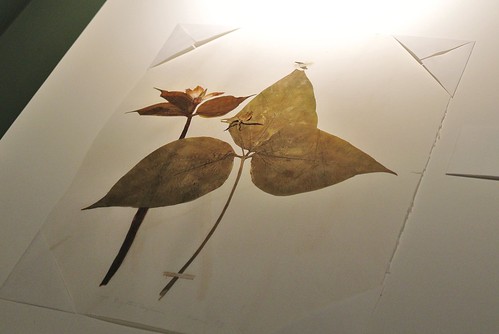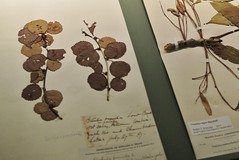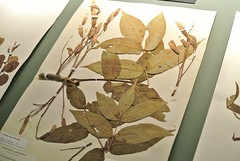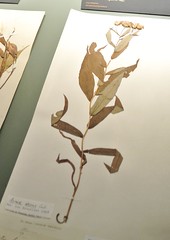Back in March when J and I went to the Harvard Museum of Natural History to see the famous glass flowers, I snapped several photographs of a more ephemeral phenomenon: several botanical specimens taken by Henry David Thoreau. Among the embarrassment of riches that is the Harvard Museum of Natural History, these pressed plants mounted on paper and labeled in Thoreau’s notoriously illegible handwriting seemed particularly fragile and astonishingly personal. When Thoreau picked, pressed, and preserved these specimens, he was acting as an amateur botanist. He had no way of knowing more than a century and a half later, someone like me would cherish these yellowed pages as a tangible connection with a long-dead writer.
Thoreau probably never suspected his meticulous botanical records—not only the 900-some specimens housed at the Botany Libraries of Harvard University or the two held by the University of Connecticut, but also the lists of first-flowering dates for the wildflowers he observed in Concord, Massachusetts from 1851 until 1858—would someday be used to study climate change. Thoreau intended to compile his seasonal observations into a project he called the Kalendar, by which he could ascertain the date simply by studying what was blooming in Concord at any given moment. Thoreau died before his Kalendar was complete, but even an incomplete project can eventually bear fruit if it is ambitious and accurate enough.
I’m currently reading Richard B. Primack’s Walden Warming: Climate Change Comes to Thoreau’s Woods, which chronicles how Thoreau’s nineteenth century observations are contributing to twenty-first century climate science. Primack is a biology professor at Boston University, and he and a team of graduate students have spent the past decade comparing Thoreau’s first-flowering dates with modern observations of Concord flora. Because Thoreau kept such a meticulous record of what bloomed when in Concord, Primack and his colleagues are able to track the acceleration of the seasons, with species such as highbush blueberry blooming between three and six weeks earlier today than in Thoreau’s day.
Primack’s book is grim reading insofar as it confirms the dire warnings of climate scientists. But part of me is cheered by Thoreau’s unintended contribution to the project. Thoreau liked to say he was born in the nick of time, but his death of tuberculosis in 1862 has always struck me as painfully premature. Thoreau was only 44 at the time of his death, and he left many unfinished projects. He didn’t live long enough to see the abolition of slavery, he never completed his Kalendar, and most of his book-length works were published posthumously, with only A Week on the Concord and Merrimack Rivers and Walden appearing during his lifetime.
Because of global warming, the spring wildflowers in Concord, Massachusetts are blooming earlier these days, but it seems that Thoreau himself was a late bloomer, becoming popular as a writer, philosopher, and citizen scientist only after his death. I often wonder whether Thoreau lamented on his deathbed the work he left undone: did it seem silly to have spent so much time gathering data for a project he couldn’t complete? I like to imagine that in his heart of hearts, Thoreau had faith that even a feeble seed would bear fruit, albeit years later. I like to imagine Thoreau himself wouldn’t be surprised his meticulous botanical records would be pored over and appreciated eventually, in the nick of (another) time.





Aug 6, 2014 at 7:42 am
Lovely post! I had no idea about Thoreau’s records and the use to which they are being put. It’s amazing to think how much he can still teach us.
LikeLike
Aug 12, 2014 at 12:18 am
It really makes you think about the absurdity of life, in that anything you do can have a lasting impact, whether or not its intended. Something so innocent and recreational as collection botanical specimens have led to evidence of global warming. It makes me wonder, what will the affects of your or my words have?
LikeLike
Aug 12, 2014 at 3:46 pm
[…] have recently come across two articles, one from a fellow blogger and one straight off of the Smithsonian webpage, in which the authors detailed Thoreau’s fairly […]
LikeLike